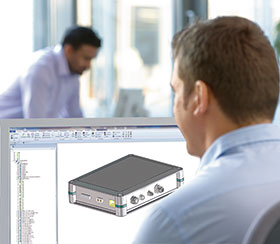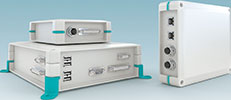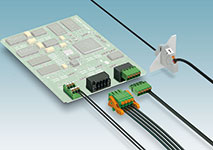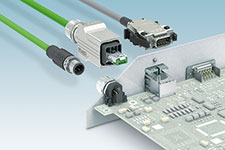

High-performing, easily adaptable and highly available – for quite some time now embedded systems have been more than just invisible mini-computers.
In decentralised automation structures, they fulfil an assortment of control, regulation and communication functions. Thanks to the rapid increase in the performance of integrated software and hardware, embedded systems play a key role in the efficient networking of autonomous functions to complex, complete systems.
Complexity of requirements
Current technological developments – Industry 4.0, Internet of Things, e-mobility, energy efficiency – call on developers of embedded systems to meet a variety of requirements. Extreme miniaturisation, continuously growing computing power and efficient communication between systems in a network have long become routine.
The major areas of focus for users of embedded systems are the reliability of the electronics as well as the suitability for trendsetting applications. And the desire for high flexibility and long-term availability consistently plays a key role in this context.
The development of electronic devices based on embedded systems boasts many advantages for device manufacturers, and they can respond swiftly to new market requirements. A comprehensive range of components on the market reduces development work, meaning the device manufacturer also benefits economically from the time saved. With the symbiosis of adaptive housing solutions and standardised interfaces, Phoenix Contact offers reliable solutions based on established standards and common norms for different market requirements.
The Universal Case System ‘UCS’
Device manufacturers use both standardised and in-house developed printed circuit boards, which require a housing that effectively protects against environmental impacts. The market offers an almost inconceivably large number of enclosure systems serving this purpose. The systems are manufactured either specifically for an application, or basic housings are modified for the respective application at great expense.

If the electronics are to be used both inside and outside the control cabinet, then different housing solutions are required, and oftentimes housings are purchased from different manufacturers. More and more device manufacturers also want to stand out from the competition through the sophisticated design of their devices, and they want to be able to respond quickly to customer-specific requirements. This is where the modular design of the Universal Case System (UCS) is particularly advantageous to the device manufacturer seeking the right solution for their electronics (Figure 1).
The UCS housing consists of two identical half-shells, removable side panels and colour-contrasting corner inserts. If more installation space is required for the same area, the system offers an interesting solution: side panels and screws are replaced by a 20 mm higher version and supplemented by a height adaptor. This makes it easy to generate a new housing size.
The design can also be easily modified using other colours or materials. Corner inserts and half-shells can still be used. The UCS system was designed so that the longer side panel can also be used as the shorter side panel in the next larger housing variant. The advantage here is that the easy-to-machine side panel for integrating the corresponding interfaces is available for various applications.
Variable or fixed PCB mounting
The Universal Case System offers two ways of mounting PCBs. In order to make maximum use of the PCB surface, the PCBs are fixed directly to the corner insert with an integrated screw boss. If maximum flexibility is to be achieved in the positioning of the PCBs, the corner inserts are used without the integrated screw boss.
To fasten the PCB, specially designed screw bosses are used that are simply glued in place. This allows different PCBs to be accommodated in one housing. The modular UCS housing also offers the possibility of positioning several PCBs in each of the two half-shells.
Connections for efficient wiring

The housing itself is one strength of the UCS. The other strength is the universal and standardised interfaces – on the PCB and externally. With COMBICON, a product range that has been on the market for decades, Phoenix Contact has appropriate interfaces on offer here (Figure 2). The range includes screw or push-in spring connections, PCB terminal blocks and connectors. Common manufacturing processes such as soldering, press-fitting or direct plugging are also supported.
Connection technology requirements on the PCB have changed in recent years. Today the type of connection technology, the required installation space on the PCB and the soldering process itself play a major role. In the field of connection technology, the push-in spring connection is now largely established on the market and has excelled in particular. With the push-in connection, rigid and stranded conductors with ferrules can be connected simply by plugging them in, without having to open the terminal compartment.
Miniaturisation also does not stop at the components on the PCB. Here, too, a comprehensive product range of corresponding connectors is available. These connectors, which have been designed for high contact density, can also be easily handled in SMD (surface-mounted device) and THR (through hole reflow) soldering processes.
Signals, data and power
Intelligent devices based on embedded systems only achieve their high functionality with appropriate device interfaces and transmission solutions. Passive connection components such as device and field connectors determine how functional a device is and how flexibly it can be adapted to different areas of application.

For the transmission of signals, data and power, Phoenix Contact has its PLUSCON connector range, which has also been available on the market for decades (Figure 3). The M5 to M12 circular connectors can be used to implement universal cabling systems.
In order to integrate these optimally into the embedded systems, the circular connector solutions are available for all common soldering processes. They also feature all the conventional pin assignments with an identical design-in design. This means that matching PCB and device panel levels can be implemented in devices of the same size.
The connectors from the PLUSCON data product range were designed for secure and reliable data transmission. With their industrial design and innovative connection technology, these connectors add important external functions to the UCS housing solution.
Summary
The market for embedded systems will continue to grow strongly, especially in view of the major transformations being brought about by Industry 4.0 and the Internet of Things. In this dynamic environment, manufacturers of electronic devices need universal and flexible housing solutions.
The Universal Case System and the numerous connection technologies offer manufacturers great potential for implementing creative product ideas. In particular, the modular design of the housing and standardised connection technologies reduce production costs and enable the device manufacturer to quickly and easily meet market requirements.
For more information contact Richard Schoonebeek, Phoenix Contact, +27 11 801 8200, [email protected], www.phoenixcontact.co.za
| Tel: | +27 11 801 8200 |
| Email: | [email protected] |
| www: | www.phoenixcontact.co.za |
| Articles: | More information and articles about Phoenix Contact |

© Technews Publishing (Pty) Ltd | All Rights Reserved